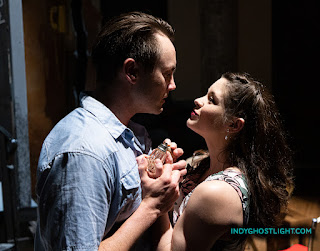Longest-running stage show ever ends the Indiana Repertory Theatre season
Critics of movies and theater are usually scrupulous about avoiding spoilers that tell how what they're reviewing turns out. Why give people any more ammunition against critics than they already have?
"The Mousetrap," an A-list murder mystery by Agatha Christie, is unusual on two counts: It's well-known as the longest-running stage drama ever; at the same time, there's a convention of warning every audience not to reveal "whodunit." That's what Charles Pasternak does at the curtain call of Indiana Repertory Theatre's season-ending production, his cast mates adding some admonitory finger-pointing.
Chances are the revelation has been made from time to time since the 1952 premiere. But it won't be here. And my assessment of the performances by Courtney Sale's excellent cast will have to skirt explanations that would explain too much.
There's something fishy about all the red herrings the playwright tosses into our path. I'm still trying to figure out if I should make anything out of the fact that Giles Ralston, married just a year to Mollie and setting up shop with her as proprietor of a country guest house, misspells the name of the place on the sign he's painted. I've concluded that's merely a part of the slightly Fawlty Towers aspect of the fledgling hosts that makes the first part of the show a comedy of manners.
False leads and cunning deceptions are part of the genre Christie so durably represents. In "The Mousetrap," everyone who descends upon Monkswell Manor and becomes snowbound on a winter evening near an English village in the early 1950s has something to hide. The recent disruptions in life caused by the Second World War have turned normal British reserve into a web of secretiveness spun by each person. Christie makes the most of this setting and keeps audience identification of the murderer far out of reach.
The production puts a virtuoso cap to the 2015-16 IRT season. Robert M. Korharchik's set looks as if it had been imported piece by piece from England. It's gorgeous in its dark-wood splendor, suggesting both the trappings of leisure and of the mystery that's about to unfold. Its majestic staircases are used with dizzying abandon, with frequent references to back stairs we never see. The music of David Dabbon, keyed to "Three Blind Mice" and distortions of the nursery tune, is tucked ominously into Todd Mack Reischman's sound design. Michelle Habeck's lighting design manages to make the environment feel both cozy and sepulchral.
I have just one quibble: At the start we hear the wall-dampened sound of howling wind and see through large windows at the rear of the set the essential falling snow. It falls straight down, not in any kind of gust-driven slant. This seems nitpicky, I know, but with this sort of show, you start to wonder: What might that mean? I've concluded that getting the snow to blow about would not have been worth the trouble. Maybe there should have been no wind sound, so that the discrepancy wouldn't arise in anyone's mind. (My sub-quibble is that hardly any actors nowadays — blessedly for their health's sake — can smoke cigarettes convincingly.)
"The Mousetrap" is Sale's swan song as IRT's associate artistic director. She has the marvelous cast continually on the move, with respites where needed. Her direction is positively symphonic. The tension embedded in the drama is consistently expressed with flair and purpose. As the plot thickens,
everyone is on edge, and the action impresses itself on our very nerve ends.
Even those characters accustomed to masking uneasiness show the effects, such as the debonair
unregistered guest, Mr. Paravicini, played suavely by Henry Woronicz. Pasternak, as Detective Sergeant Trotter, orchestrates his relentless sleuthing with large gestures and a booming, accent-perfect voice. His command is absolute, and every probing maneuver strikes home among the recalcitrant suspects. They respond as if a sore tooth had been struck with a hammer.
As Giles and Mollie Ralston, Ryan Artzberger and Cassandra Bissell projected the naivete of young marrieds embarked on a business venture they are not thoroughly prepared for. But, as seen Friday evening, they too betray subtly their need to keep secrets. Robert Neal brings his capacity for conveying outsize bluster and self-assurance to the role of Major Metcalf, who in some ways remains the drama's most mysterious character.
Jürgen Hooper rewards the audience's heightened attention to detail with his flamboyance and flutter as the young architect Christopher Wren. Thrown more conspicuously than the others into suspicion as the guilty party by his sylphlike mannerisms, he achieves a firm rapport with Mollie Ralston that adds to the suspense.
In an arresting voice of grating, precise tone, Jan Lucas portrayed the hypercritical Mrs. Boyle. As Christie doubtless intended, the performance made her fate by the end of the first act seem both plausible and deserved.
Brusque, manipulative and guarded to a fare-thee-well, the rolling-stone character of Miss Casewell was accurately well-cased in Jennifer Johansen's performance.
'The Mousetrap" is captivating and haunting. Just as you probably never thought of "Singin' in the Rain" the same way after seeing "A Clockwork Orange," you will be newly alert to a less innocent song called "Three Blind Mice" after "The Mousetrap." Did you ever see such a sight in your life, indeed!
[Photos by Zach Rosing]
"The Mousetrap," an A-list murder mystery by Agatha Christie, is unusual on two counts: It's well-known as the longest-running stage drama ever; at the same time, there's a convention of warning every audience not to reveal "whodunit." That's what Charles Pasternak does at the curtain call of Indiana Repertory Theatre's season-ending production, his cast mates adding some admonitory finger-pointing.
Chances are the revelation has been made from time to time since the 1952 premiere. But it won't be here. And my assessment of the performances by Courtney Sale's excellent cast will have to skirt explanations that would explain too much.
 |
| Ryan Artzberger and Cassandra Bissell as the host Ralstons. |
False leads and cunning deceptions are part of the genre Christie so durably represents. In "The Mousetrap," everyone who descends upon Monkswell Manor and becomes snowbound on a winter evening near an English village in the early 1950s has something to hide. The recent disruptions in life caused by the Second World War have turned normal British reserve into a web of secretiveness spun by each person. Christie makes the most of this setting and keeps audience identification of the murderer far out of reach.
 |
| Detective Sergeant Trotter makes a firm point to Christopher Wren. |
I have just one quibble: At the start we hear the wall-dampened sound of howling wind and see through large windows at the rear of the set the essential falling snow. It falls straight down, not in any kind of gust-driven slant. This seems nitpicky, I know, but with this sort of show, you start to wonder: What might that mean? I've concluded that getting the snow to blow about would not have been worth the trouble. Maybe there should have been no wind sound, so that the discrepancy wouldn't arise in anyone's mind. (My sub-quibble is that hardly any actors nowadays — blessedly for their health's sake — can smoke cigarettes convincingly.)
"The Mousetrap" is Sale's swan song as IRT's associate artistic director. She has the marvelous cast continually on the move, with respites where needed. Her direction is positively symphonic. The tension embedded in the drama is consistently expressed with flair and purpose. As the plot thickens,
everyone is on edge, and the action impresses itself on our very nerve ends.
Even those characters accustomed to masking uneasiness show the effects, such as the debonair
 |
| Henry Woronicz as an Italian whose car slid off the road nearby |
As Giles and Mollie Ralston, Ryan Artzberger and Cassandra Bissell projected the naivete of young marrieds embarked on a business venture they are not thoroughly prepared for. But, as seen Friday evening, they too betray subtly their need to keep secrets. Robert Neal brings his capacity for conveying outsize bluster and self-assurance to the role of Major Metcalf, who in some ways remains the drama's most mysterious character.
Jürgen Hooper rewards the audience's heightened attention to detail with his flamboyance and flutter as the young architect Christopher Wren. Thrown more conspicuously than the others into suspicion as the guilty party by his sylphlike mannerisms, he achieves a firm rapport with Mollie Ralston that adds to the suspense.
 |
| Mrs. Boyle and Miss Casewell get acquainted, to a degree. |
Brusque, manipulative and guarded to a fare-thee-well, the rolling-stone character of Miss Casewell was accurately well-cased in Jennifer Johansen's performance.
'The Mousetrap" is captivating and haunting. Just as you probably never thought of "Singin' in the Rain" the same way after seeing "A Clockwork Orange," you will be newly alert to a less innocent song called "Three Blind Mice" after "The Mousetrap." Did you ever see such a sight in your life, indeed!
[Photos by Zach Rosing]



Comments
Post a Comment